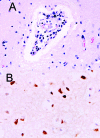Probable tiger-to-tiger transmission of avian influenza H5N1
- PMID: 15890122
- PMCID: PMC3320363
- DOI: 10.3201/eid1105.050007
Probable tiger-to-tiger transmission of avian influenza H5N1
Erratum in
- Emerg Infect Dis. 2005 Jun;11(6):976
Abstract
During the second outbreak of avian influenza H5N1 in Thailand, probable horizontal transmission among tigers was demonstrated in the tiger zoo. Sequencing and phylogenetic analysis of those viruses showed no differences from the first isolate obtained in January 2004. This finding has implications for influenza virus epidemiology and pathogenicity in mammals.
Figures


References
Publication types
MeSH terms
Associated data
- Actions
- Actions
LinkOut - more resources
Full Text Sources
Other Literature Sources
Medical
